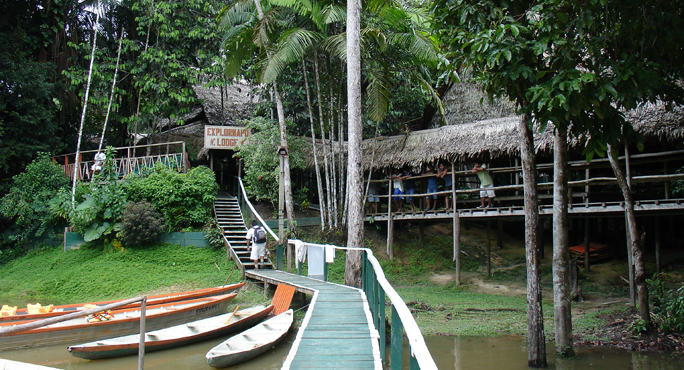Photo by Chris Kilham
Almost everybody knows about the Amazon, the world’s greatest rainforest, watered liberally by the world’s largest river and its multitude of tributaries. The Amazon rainforest stretches over a billion acres in Brazil, Venezuela, Columbia, and the Eastern Andean area of Ecuador and Peru. More than 20 percent of the world’s oxygen is produced in the Amazon rainforest. This has earned the area the name “the lungs of the planet.” The Amazon basin also holds one-fifth of the world’s fresh water.
Five hundred years ago, an estimated 10 million natives lived in the Amazon rainforest. Today, fewer than 700,000 survive. As native people vanish, their knowledge fades away with the sands of time. This is true for native languages, stories, crafts and natural medicines. Most medicine men and women and shamans remaining in the Amazon Rainforest are 70 years old or older.
Each time one dies, a vast body of knowledge is lost. Because this is so, any efforts that help to preserve and promote that knowledge are very worthwhile.
This is where Explorama Lodges come in. The brainchild of anthropologist Peter Jenson, the three Explorama Lodges in the Peruvian Amazon give people the opportunity to travel to the Amazon, to do so safely, to have a place to stay, and to learn about some of the medicinal plants of the world’s greatest rainforest. I have taken students from the University of Massachusetts to one of the Explorama Lodges, ExplorNapo, and can say that it was certainly the high point of my 10-year teaching career at that institution.
Each of the three Explorama Lodges is surrounded by rainforest that has been set aside in conservation. This means that if you go to one or more of the lodges, you won’t be seeing bulldozers plowing down swaths of forest, which is happening all over the Amazon. This also means that you will see wildlife, from toucans and parrots, to monkeys, tapirs and sloths.
Of the three lodges, the most remote of them is ExplorNapo, situated in a serene spot surrounded by undisturbed primary rainforest on the beautiful Sucusari River. This rustic lodge offers immediate access to spectacular rainforest, and to the ReNuPeru Botanical Garden, a collection of medicinal plants assembled under the direction of former USDA head botanist Dr. James Duke. Those in the know need no introduction to Dr. Duke. One of the greatest experts on medicinal plants alive today, Duke has attracted worldwide attention for his high level of scholarship, his humorous southern personality, and his extraordinarily prolific output, including his best-selling herbal guide The Green Pharmacy. The ReNuPeru garden allows visitors to learn about many of the highly beneficial plant medicines in the Amazon, in the company of trained guides who grew up in the forest.
You can even get a temporary tattoo from one of the two resident shamans there, who apply native designs using a natural dye from a local tree fruit.
A mere 45 minute walk through the forest from the ExplorNapo Lodge, the ACTS (Amazon Conservatory of Tropical Studies) canopy walkway offers an incomparable view of the Amazon rainforest- from above. Eco-tourists, students, botanists and researchers travel to the ACTS canopy walkway to view the forest, and to study plants, animals and insects. When I took students from U Mass there, they did not want to leave. The walkway connects 19 trees with sturdy pathways suspended by tough nylon rope and powerful wire cables, with flat surfaces to walk on. Each tree on the walkway hosts a platform, and the walkway itself goes from the ground to a height of 115 feet. When you stand atop the higher platforms and gaze out over tens of miles of pristine forest as wild toucans fly by, you cannot help but be deeply touched. And that is one of the reasons for its existence. Once you see the Amazon for yourself, it is natural to want to help in some way to preserve it.
At night, you can hear millions of forest creatures making sounds you will only hear in that environment. Hoots, whistles, caws, screechings, beeps, hums, buzzes, clicks and thousands of other sounds create a natural symphony, which fills the night air. One of the favorite activities of the guides at the lodge is to take guests out onto the Sucusari River after dinner, to drift along in the dark, shining flashlights into the trees on the banks, to look for animals, from birds to snakes. You never know what you are going to see.
Hundreds of years ago, approximately 14 percent of the world’s surface was covered with rainforests. Today, that acreage has been whittled down to less than 6 percent, and still the destruction of Earth’s rainforests goes on unabated. Logging, petro-exploration, mining, cattle grazing and other extractive industries ruin forest, remove natural resources, and leave behind a bleak and destroyed landscape. I know – I see it every time I travel to that area. This is why I suggest you take a trip to Peru and stay at the Explorama lodges, notably ExplorNapo. See the forest for yourself. Learn about plant medicines in the ReNuPeru garden. Travel out on the river. Hike through rainforest to the canopy walkway and gaze out over the glistening green.
Who knows – perhaps you too will be move to engage in efforts to preserve the greatest and most bio-diverse rainforest on earth.


